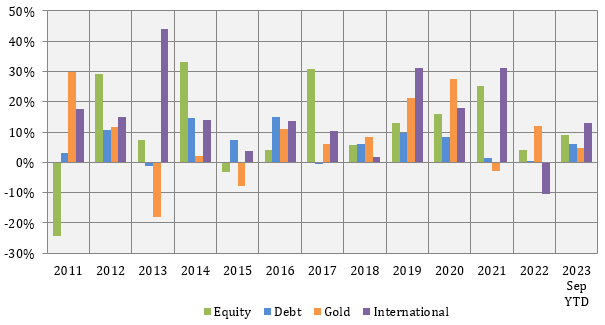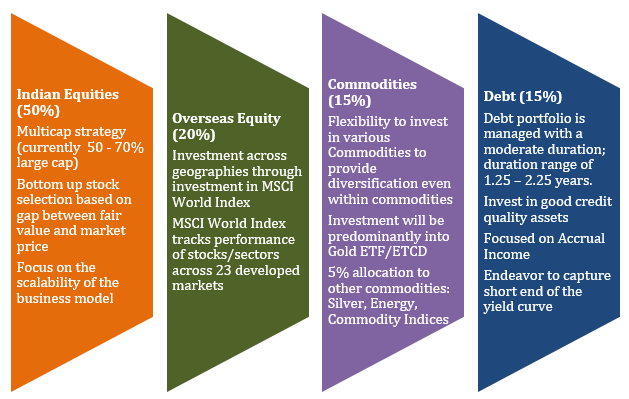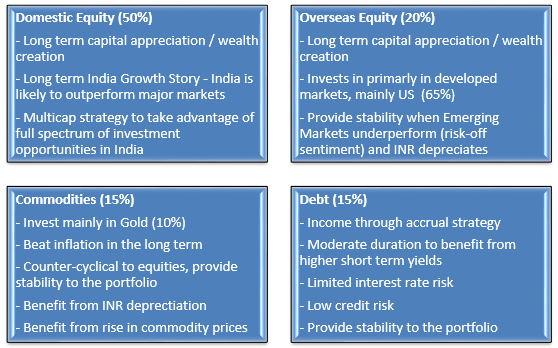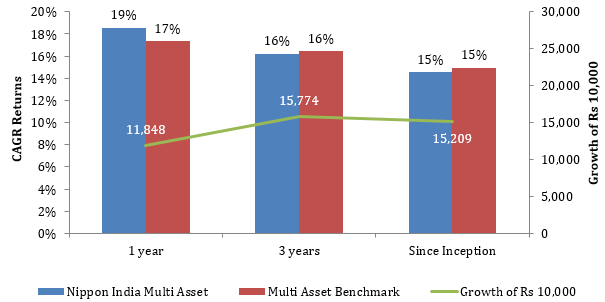Importance of fixed asset allocations in multi asset strategy

Asset allocation is the diversification of funds across various asset classes like equity, debt, commodities etc. with the objective of balancing the risks with returns. Asset allocation has traditionally been looked at as allocating investment between equity, and debt. In recent months, multi asset allocation funds which invest 3 or more asset classes have attracted investor interest. In September 2023, the inflow from Multi Asset allocation fund reached Rs 6,324 crore which was Rs 4,707 crore more than the August inflows (source: AMFI monthly data).
With “risk off” sentiments in FIIs due to high US bond yields, Israel Hamas conflict and the rising crude oil prices, investors are looking at asset allocation solutions to get stability in the short term and get superior returns compared to traditional fixed income investments in the long term. Multi asset allocation strategy can be suitable in these market conditions. For example, in the last one month Nifty 50 has fallen by 5.5%, but Gold has gained 6.0% (source: NSE, Moneycontrol, as on 26th October 2023).
What are Multi asset allocation funds?
Multi Asset Allocation Funds are a type of hybrid fund that invests in various asset classes like debt, equities, commodities and other asset classes. Multi Asset Allocation funds are required to invest a minimum of 10% of their total AUM in each of three or more different asset classes in order to diversify their asset allocation.
Different asset classes follow different investment cycles over different time periods (see the chart below). It is difficult to predict which Asset class will outperform.

Source: National Stock Exchange, Advisorkhoj Research, as on 29th September 2023. Equity as an asset class is represented by Nifty 50 TRI, debt as an asset class has been represented by Nifty 10 year benchmark G-Sec and for gold we have used MCX spot prices, international is represented by S&P 500 in INR. Disclaimer: Past performance may or may not be sustained in the future.
NIPPON INDIA MULTI ASSET FUND (NIMAF)
The Nippon India Multi Asset Fund is a type of open ended hybrid fund that invests in Equity, Debt and Exchange Traded Commodity Derivative and Gold, with the primary objective of creating long term capital growth.
The current asset allocation of the fund is as follows.

Importance of fixed asset allocation in multi asset strategy
- A 2001 study stated that “More than 90% of the portfolio returns are based on asset allocation decisions.” This finding holds true even today. It is the allocation of assets between different classes which ensures capital appreciation over the long term.
- Fixed asset allocation is the main driver of long term portfolio returns. The asset allocations of domestic equity, overseas equity, commodity and debt are determined to ensure the optimal balance of risk and returns.
- The asset allocation model is back-tested to see how the model performed across investment cycles
- Fixed allocation enables fund managers to use buy and hold strategy for the equity portion (both domestic and international) of the portfolio. Buy and hold over long investment horizons can produce superior absolute returns.
- Gold prices are directly affected by monetary policy or interest rates. When the central banks ease monetary policy, gold prices rise with a lag. When central banks tighten monetary policy, gold returns are lower or even negative. In the long term, Gold has beaten inflation. A fixed allocation to Gold can produce superior returns over long investment horizons.
- Fixed allocation within certain bands entails lower transaction costs since the portfolio churning is relative lower. Lower costs can result in superior long term performance.
- Fixed asset allocation enables performance comparison versus the benchmark index and lower active risk. If the asset allocation of a hybrid fund deviates significantly from the benchmark index then the active risk is higher. For example, if the benchmark index of a hybrid scheme comprises of 50% equity and 50% debt, while the scheme has 20% equity and 80% debt, then the scheme is likely to underperform the benchmark if the equity market continues to rise.
- Fixed asset allocation ensures more tax efficient returns. You should consult with your financial advisor or mutual fund distributor to understand the tax consequences of your multi asset allocation fund.
Role of different asset classes in Nippon India Multi Asset Fund

Performance of Nippon India Multi Asset Fund

Source: National Stock Exchange, Advisorkhoj Research, as on 29th September 2023.
Is this a good time to invest in Nippon India Multi Asset Fund?
- US Treasury bond yields continue to be very high. This is causing FIIs reallocate their investments from equities to US Treasury Bonds.
- Emerging market equities are likely to be affected more than developed markets in risk-off global investor sentiments.
- There are no signs of the Israel Hamas conflict ending soon. On the contrary, there are growing concerns of the conflict expanding to a regional one.
- Brent crude oil prices are near $90 per barrel and can go higher if the current conflict expands to the Middle East.
- Gold will continue rally if commodity prices rise further and multi-asset strategy is likely to provide stability to your portfolio.
- Overseas equity, especially developed markets will also provide diversification benefits if emerging markets underperform due to worsening global risk sentiments.
- Over long investment horizon, the domestic equity allocation of the fund can create wealth for investors on the back of long term secular India Growth Story.
Contact your financial advisor or mutual fund distributor for advice on how the Nippon India Multi Asset Fund can be suitable for your investment needs.
Mutual Fund Investments are subject to market risk, read all scheme related documents carefully.
Queries
-
What is the benefit of mutual fund STP
Aug 29, 2019
-
How much to invest to meet target amount of Rs 2 Crores
Aug 26, 2019
-
Can I achieve my financial goals with my current mutual fund investments
Aug 24, 2019
-
Can you tell me return of various indices
Aug 19, 2019
-
What would be the post tax return on different investments
Aug 18, 2019
-
Which Principal Mutual Fund scheme will be suitable for my retirement corpus
Aug 16, 2019
-
What is the minimum holding period for availing NCD interest
Aug 4, 2019
Top Performing Mutual Funds
Recommended Reading
Fund News
-
The Wealth Company Mutual Fund launches The Wealth Company Gold ETF FOF
Jan 9, 2026 by Advisorkhoj Team
-
Mahindra Manulife Mutual Fund launches Mahindra Manulife Innovation Opportunities Fund
Jan 9, 2026 by Advisorkhoj Team
-
Jio BlackRock Mutual Fund launches Jio BlackRock Short Duration Fund
Jan 8, 2026 by Advisorkhoj Team
-
Jio BlackRock Mutual Fund launches Jio BlackRock Low Duration Fund
Jan 8, 2026 by Advisorkhoj Team
-
Groww Mutual Fund launches Groww Small Cap Fund
Jan 8, 2026 by Advisorkhoj Team














